Delhi travel - India, Asia
Delhi, the bustling capital of India, is located in north-central India on the west bank of the Yamuna River, just south of the Himalayas. With a population as the second most populated city in the world, offering a dynamic mix of ancient and modern life. The city’s history stretches back over two millennia, having served as the capital of various empires, including the Delhi Sultanate and Mughal Empire. It became the capital of British India in 1911 and continues to be the political heart of independent India since 1947.
Delhi’s unique character lies in its dual identity, with Old Delhi showcasing rich history and New Delhi representing the nation’s modern face. The city boasts iconic landmarks like the Qutub Minar, Humayun’s Tomb, and the Red Fort, all of which are UNESCO World Heritage Sites. Visitors are also drawn to Delhi’s vibrant cultural diversity, religious sites, and thriving culinary scene, especially its famous street food. As a major economic and educational hub, Delhi seamlessly blends its architectural marvels, green spaces, and bustling markets, making it a must-visit destination for travelers.
Population: Estimate 33,800,000 (as of 2024)
Economy: Delhi is a dynamic and multifaceted landscape that plays a crucial role in India's overall economic framework. The services sector is the backbone of Delhi's economy, contributing about 70.95% to the GSDP. Key industries include information technology, telecommunications, banking, media, and tourism. The city is also a hub for hotels and hospitality, benefiting from its status as a major tourist destination. The city attracts a large number of domestic and international tourists, drawn by its rich historical heritage and modern attractions. In 2016, tourism generated about US$3.2 billion, supporting over 460,000 jobs.
Landmarks: Qutub Minar, Red Fort, Humayun's Tomb, Lotus Temple, India Gate, Jama Masjid, Raj Ghat, Akshardham Temple
Explore more tours in India here.
India

Overview of Delhi
History & Cultural Influence
Delhi's history dates back to ancient times, with references to a city called Indraprastha in the epic Mahabharata. Over the centuries, it has been the site of numerous settlements, including eight major cities built in succession, such as Lal Kot, Siri, and Shahjahanabad.
From the 13th century onwards, Delhi became the capital of significant empires, including the Delhi Sultanate and the Mughal Empire. The city flourished under the Mughals, who left a lasting architectural legacy, including the Red Fort, Humayun's Tomb, and Qutub Minar, all of which are UNESCO World Heritage Sites. These monuments reflect the grandeur of Mughal architecture and the cultural synthesis of Persian and Indian styles.
In the early 20th century, Delhi was chosen as the capital of British India, leading to the establishment of New Delhi, characterized by colonial architecture such as the Rashtrapati Bhavan and India Gate. This period marked a shift in the city's administrative and cultural landscape, integrating Western influences alongside traditional Indian elements.
Following India’s independence in 1947, Delhi transformed from a Mughal city to a melting pot of cultures, particularly with the influx of refugees from Punjab. This demographic shift enriched the city’s cultural tapestry, introducing new languages, cuisines, and traditions.
Delhi's architecture is a testament to its rich history, showcasing a blend of ancient, Mughal, colonial, and modern styles. Significant structures like the Jama Masjid, Akshardham Temple, and the Lotus Temple illustrate this diversity. The city is also home to numerous heritage buildings recognized by the Archaeological Survey of India.
Interaction with The Locals
As one of the most populous cities in the world, Delhi is home to a diverse population, representing a wide range of ethnicities, languages, and religious backgrounds. When interacting with locals in Delhi, visitors can expect a vibrant and diverse experience that reflects the city's rich cultural heritage and welcoming spirit. Delhi's population is predominantly Hindu, with significant Muslim, Sikh, and Christian minorities. The city is a melting pot of cultures, with residents hailing from various parts of India and beyond. This diversity is reflected in the languages spoken, with Hindi being the most widely used, followed by Punjabi, Urdu, and English.
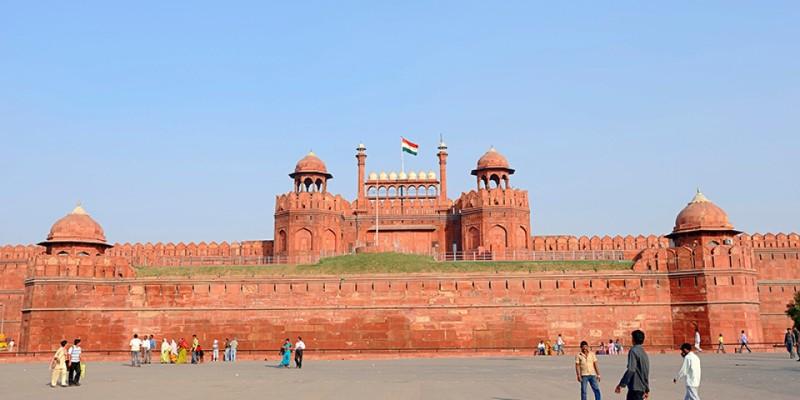
Red Fort - © Christian Hütter
Top attractions in Delhi
Delhi offers travelers a blend of history and modernity, with must-see attractions like the majestic Red Fort, the iconic India Gate, and the serene Lotus Temple. Explore bustling markets in Chandni Chowk and the tranquil beauty of Humayun's Tomb, all reflecting the rich cultural tapestry of India.
Red Fort (Lal Qila)
Location: Netaji Subhash Marg, Chandni Chowk, New Delhi
This iconic UNESCO World Heritage Site is a masterpiece of Mughal architecture, constructed in 1638. Its towering red sandstone walls and intricate detailing showcase the grandeur of the Mughal Empire. The fort is not just an architectural marvel but also a powerful symbol of India's struggle for independence, making it a must-visit for history enthusiasts.
Qutub Minar
Location: Mehrauli, New Delhi
Standing at 73 meters, Qutub Minar is the tallest brick minaret in the world and another UNESCO World Heritage Site. Built in the 12th century, it is an exquisite example of Indo-Islamic architecture, adorned with intricate carvings and inscriptions from the Quran. Its historical significance and stunning design make it a remarkable attraction.
Humayun's Tomb
Location: Mathura Road, Nizamuddin, New Delhi
A precursor to the Taj Mahal, this garden tomb is a magnificent example of Mughal architecture. Completed in 1572, Humayun's Tomb is a UNESCO World Heritage Site and features stunning gardens, intricate tile work, and a serene atmosphere that captivates visitors.
Lotus Temple (Bahá'í House of Worship)
Location: Bahapur, New Delhi
The Lotus Temple is a modern architectural marvel known for its unique flower-like design. Opened in 1986, it serves as a place of worship for people of all faiths and is surrounded by peaceful gardens, making it an ideal spot for meditation and reflection.
Jama Masjid
Location: Old Delhi, New Delhi
One of India's largest mosques, Jama Masjid was constructed between 1650 and 1656. Its striking red sandstone and white marble architecture can accommodate thousands of worshippers. Climb its minarets for breathtaking views of the vibrant streets of Old Delhi, offering a glimpse into the city's rich cultural tapestry.
Hauz Khas Village
Location: Hauz Khas, New Delhi
A perfect blend of history and modernity, Hauz Khas Village is a trendy neighborhood that houses ancient ruins alongside contemporary cafes, boutiques, and art galleries. The Hauz Khas Complex, with its 13th-century water tank surrounded by greenery, offers a picturesque escape within the bustling city, attracting both locals and tourists.
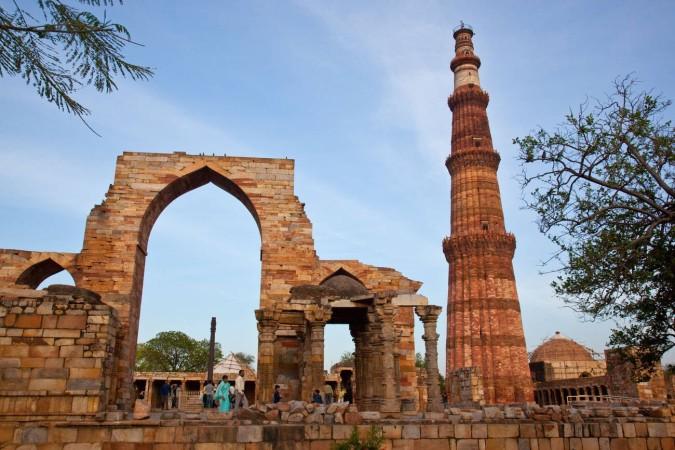
Qutub Minar - © gather
Must-Try Dishes in Delhi
Delhi is a food lover's paradise, offering must-try dishes like the spicy and flavorful Chole Bhature, and the tender, succulent Kebabs. Don't miss out on the famous street food like Golgappas and the rich, creamy Butter Chicken that perfectly capture the essence of Delhi's diverse culinary heritage.
- Chole Bhature: A quintessential North Indian delight, Chole Bhature pairs spicy chickpeas with fluffy, deep-fried bread. Often consumed for breakfast or lunch, this fulfilling dish is celebrated for its bold flavors and hearty texture. Noteworthy places to relish Chole Bhature include Sita Ram in Paharganj and Chache Di Hatti in Kamala Nagar.
- Butter Chicken: A creation of Delhi from the 1950s by Moti Mahal, Butter Chicken or Murg Makhani is a symphony of tender chicken pieces bathed in a velvety, spiced tomato sauce. A global ambassador of Indian cuisine, it's best enjoyed with naan or rice. For an authentic taste, visit famed establishments like Karim’s and Moti Mahal.
- Kebabs: Delhi's reputation for its kebabs stretches far and wide, showcasing varieties such as seekh, galouti, and shami. These skewered marvels of marinated meat, grilled to smoky perfection, are a nod to the city’s rich Mughal culinary traditions. For the uninitiated, Abdul Malik Chicken Corner and Karim’s offer some of the best in the city.
- Parathas: A visit to Paranthe Wali Gali in Chandni Chowk promises an indulgent experience with its assortment of stuffed parathas. Whether it's filled with potatoes, paneer, or minced meat, each flaky flatbread is served with pickles and yogurt, epitomizing Delhi’s vibrant street food scene.
- Gol Gappe (Pani Puri): An exhilarating treat, Gol Gappe features hollow puris filled with a tangy mix of tamarind water, chickpeas, and potatoes. These little flavor bombs are a staple at street stalls throughout Delhi, offering a burst of taste with each bite.
- Jalebi: For those with a sweet tooth, Jalebi is a must-try. These spirals of fermented batter are deep-fried and soaked in sugary syrup, offering a crunchy yet gooey texture. The Old Famous Jalebi Wala stands out as a celebrated spot to enjoy this beloved dessert.
Craving Indian food? Learn more about Pushkar's regional cuisine here.
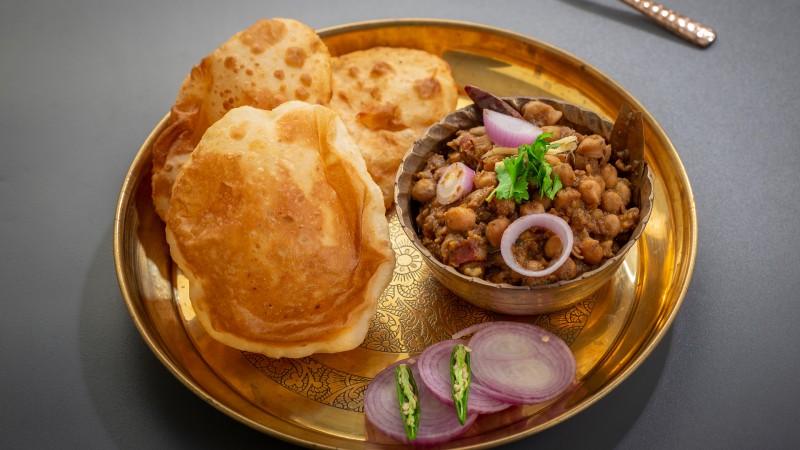
Chole Bhature - © gather
Getting Around Delhi
Public Transit
- Delhi Metro: The most efficient way to travel within the city, the Delhi Metro has an extensive network covering key areas and satellite cities. It features air-conditioned coaches, with one reserved for women. Fares depend on the distance traveled, and tokens or smart cards can be purchased at metro stations. The average frequency is every 5 minutes, making it a reliable option for commuters.
- Buses: Operated by the Delhi Transport Corporation (DTC), the bus network is extensive and affordable, covering nearly all areas of the city. However, buses can get crowded during peak hours, so it's advisable to avoid them during morning and evening rush hours.
- Rickshaws: Auto-rickshaws and cycle-rickshaws are widely available and are a popular choice for short distances. Auto-rickshaws are equipped with meters, but it's wise to confirm the fare before starting the journey, especially for non-locals. Cycle-rickshaws are a more leisurely option, particularly in congested areas.
Taxis and Ride-Sharing
- Taxis: While traditional taxis are available, they can be more expensive compared to auto-rickshaws and ride-sharing options. It's recommended to agree on a fare beforehand or ensure the meter is used.
- Ride-Sharing Services: Services like Uber and Ola provide a comfortable and often cost-effective way to travel around Delhi. They can be booked through mobile apps, and some operators offer women-only services for added safety.
Additional Options
- Hop-On/Hop-Off Buses: These tourist buses allow visitors to explore major attractions at their own pace. They cover over 25 tourist sites and offer one-day and two-day passes, making them a flexible option for sightseeing.
- Inter-State Bus Terminals (ISBT): For those traveling to and from neighboring states, Delhi has several major ISBTs, such as Kashmere Gate and Anand Vihar, providing extensive bus services across northern India.
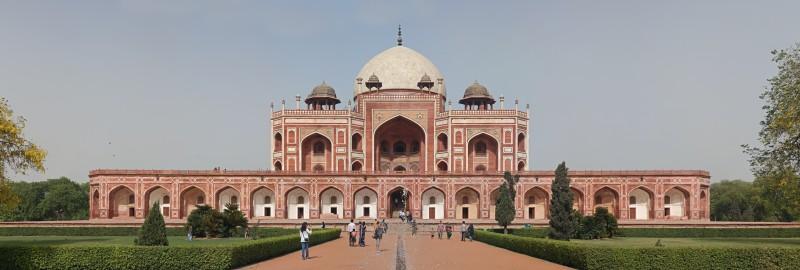
Humayun's Tomb - © Muhammad Mahdi Karim
Weather in Delhi
Delhi experiences a humid subtropical climate with very hot summers, mild winters, and a monsoon season. Here are the key details about Delhi's weather and climate to help travelers pack appropriately:
Temperatures
- Summer (April to June): Extremely hot with average highs of 40-45°C (104-113°F). Temperatures can reach up to 49°C (121°F). Pack lightweight, breathable clothing and stay hydrated.
- Monsoon (July to September): Hot and humid with average highs of 35-40°C (95-104°F) and heavy rainfall. Bring light rain jackets and umbrellas.
- Winter (December to February): Mild with average highs of 20-25°C (68-77°F) and lows of 5-10°C (41-50°F). Pack warm layers like jackets and sweaters. Temperatures can drop below freezing on some nights.
Rainfall
- Annual average: 797.3 mm (31.39 inches)
- Wettest month: July with 207.7 mm (8.18 inches)
- Driest month: November with 8.5 mm (0.33 inches)
The monsoon season brings the most rainfall, with heavy downpours and thunderstorms. Winters are mostly dry with some light rainfall.
Other Weather Patterns
- Delhi experiences dust storms, particularly in summer, which can reduce visibility.
- Winters bring dense fog, especially in December, which can disrupt transportation.
- The city is prone to air pollution, especially post-monsoon and in winter when it reaches hazardous levels.
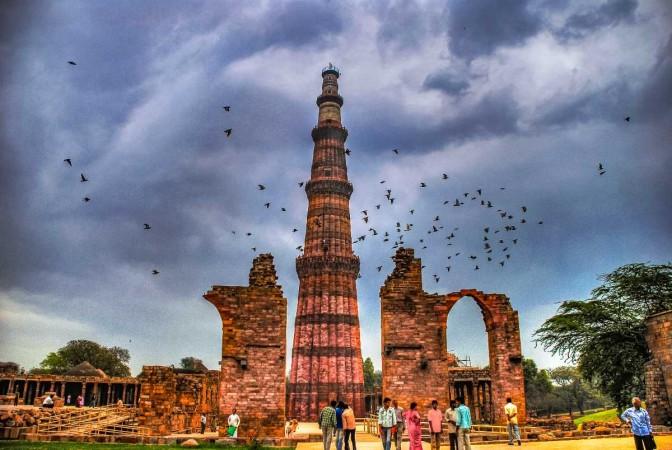
Qutub Minar Delhi - © gather
Festivals & Celebrations in Delhi
Delhi hosts a vibrant array of events and festivals throughout the year, reflecting its rich cultural heritage and diverse communities. Here are some notable events and festivals that travelers might encounter during their visit:
Major Festivals
- Independence Day (August 15): Celebrated with great enthusiasm, this day marks India's independence from British rule in 1947. The main event includes a grand parade at Rajpath, showcasing India's cultural diversity and military might.
- Diwali (October/November): Known as the Festival of Lights, Diwali is celebrated with fireworks, decorations, and family gatherings. The city is adorned with lights and diyas (lamps), making it a visually stunning time to visit.
- Holi (March): The Festival of Colors is celebrated with vibrant powders, music, and dance. People come together to smear colors on each other, making it a joyous and lively occasion.
- Dussehra (September/October): This festival commemorates the victory of good over evil, marked by the burning of effigies of Ravana. Various cultural events and fairs are organized across the city.
Cultural Events
- International Trade Fair (November): Held at Pragati Maidan, this fair showcases products from different states and countries, promoting trade and cultural exchange.
- Delhi International Arts Festival (October): A celebration of arts, this festival features performances from artists around the world, including music, dance, and theater.
- Book Fairs: Various book fairs take place throughout the year, including the Delhi Book Fair, attracting bibliophiles and authors alike.
Seasonal Events
- Christmas Celebrations (December): The festive spirit is palpable in areas with significant Christian populations, such as Connaught Place and churches across the city, featuring decorations, carols, and midnight masses.
- New Year Celebrations (December 31): Delhi's nightlife comes alive with parties, concerts, and events across clubs and restaurants, making it a vibrant time to experience the city's festivities.
Local Events
- Street Food Festivals: Throughout the year, various food festivals celebrate Delhi's rich culinary heritage, featuring local delicacies and street food.
- Cultural Programs at Dilli Haat: This open-air market hosts regular cultural events, including handicraft exhibitions, dance performances, and food festivals representing different states of India.

The Festival of Colors - © gather
Shopping in Delhi
Delhi is a shopper's paradise, offering a mix of traditional markets, modern malls, and unique boutiques. Here are some of the best shopping districts and markets to explore, especially for local crafts and souvenirs:
- Dilli Haat: An open-air market designed like a traditional village market, Dilli Haat features stalls run by artisans from various states of India. It is renowned for handicrafts, textiles, and regional cuisines. Visitors can find items like pashmina shawls, Madhubani paintings, and pottery.
- Chandni Chowk: One of the oldest and busiest markets in Delhi, Chandni Chowk is famous for its narrow lanes filled with shops selling textiles, spices, jewelry, and traditional Indian sweets. The market is divided into several smaller bazaars, each specializing in different products, making it a great place for souvenirs.
- Khan Market: A popular upscale shopping destination, Khan Market is known for its boutiques, bookstores, and cafes. It offers a mix of high-end brands and local crafts, making it ideal for those looking for unique gifts and stylish clothing.
- Janpath Market: Located near Connaught Place, Janpath is famous for its vibrant atmosphere and a wide range of products, including trendy clothing, jewelry, and accessories. It is particularly popular among tourists for its handicrafts and ethnic wear.
- Sarojini Nagar Market: Known for its affordable fashion, Sarojini Nagar is a bustling market where visitors can find trendy clothes, accessories, and home decor items at bargain prices. It’s particularly popular among college students and young shoppers.
- Paharganj Market: A hub for budget travelers, Paharganj offers a variety of goods, including textiles, jewelry, and handicrafts. The market is known for its eclectic shops and vibrant street food scene.
- Palika Bazaar: An underground shopping complex located in Connaught Place, Palika Bazaar specializes in electronics, clothing, and accessories. It is air-conditioned, making it a comfortable shopping experience, especially during the hot summer months.
Read more about other experiences in Jaisalmer, another big city in India here.
Articles for you
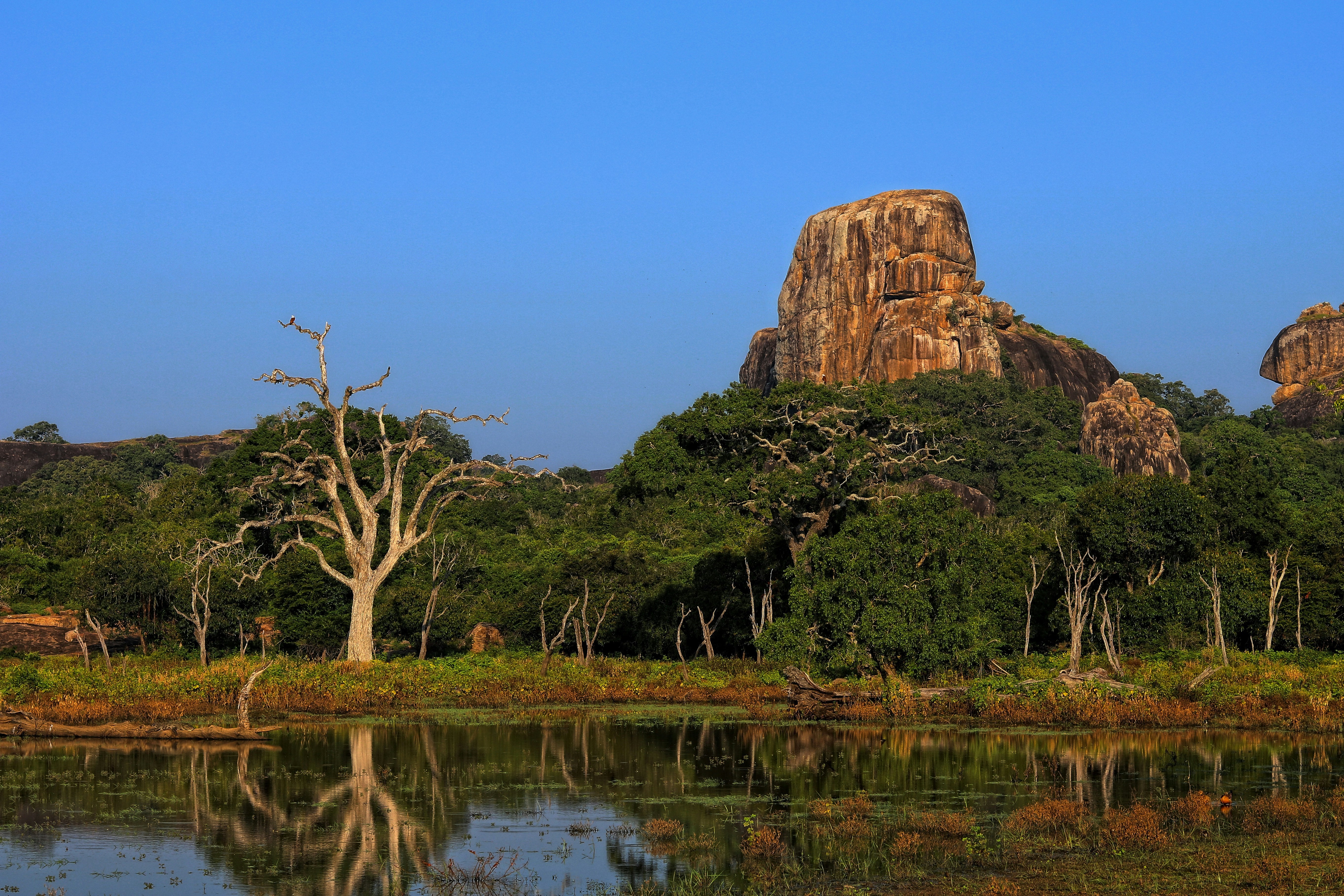
Explore Yala National Park - Sri Lanka Travel, Asia
Tucked away in Sri Lanka’s southeastern corner, Yala National Park is where wild nature meets deep tradition. Known worldwide for its leopard population, the park is also home to elephants, sloth bears, crocodiles, and hundreds of bird species. Beyond wildlife, Yala opens doors to a cultural landscape dotted with ancient temples, Buddhist ruins, and coastal villages. For travelers seeking more than just a safari, Yala offers a chance to explore eco-tourism, local communities, and sacred heritage sites.
Population: The Yala National Park area doesn’t have a human population.
Economy: The economy around Yala National Park thrives on a blend of eco-tourism, agriculture, and local services. Safari tours, eco-lodges, and cultural experiences drive steady income for nearby towns like Tissamaharama and Kataragama, supporting thousands of families.
Landmarks: Famous for Block I of Yala and wildlife encounters, including elephants, sloth bears, crocodiles, and exotic bird species.
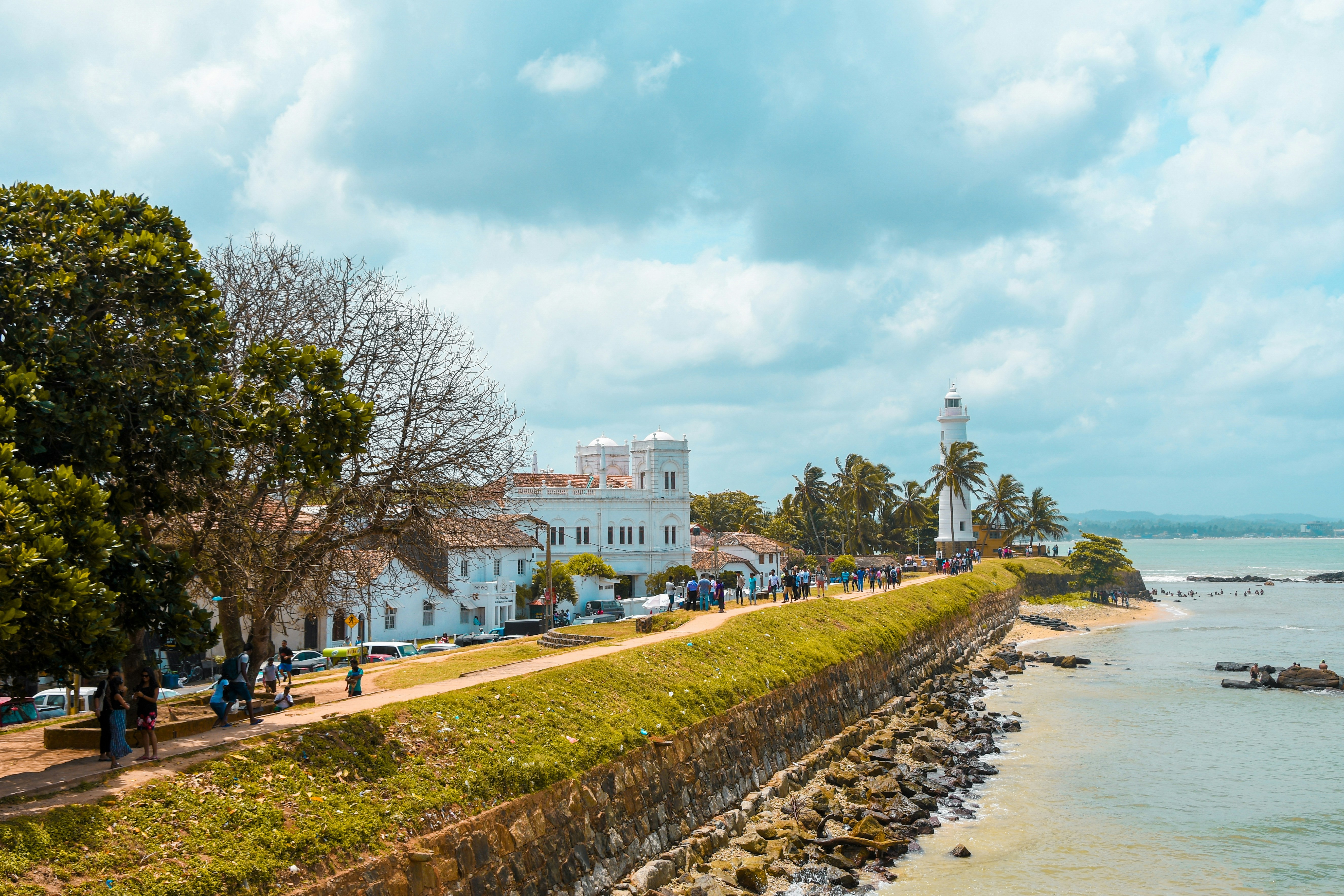
Explore Galle - Sri Lanka Travel, Asia
Nestled on Sri Lanka’s southern coastline, Galle is a vibrant city where history meets the sea. Its cobbled streets, colonial architecture, and serene beaches make it a must-visit destination for travelers seeking a blend of culture, adventure, and relaxation. A UNESCO World Heritage site, Galle captivates visitors with its Dutch Fort, bustling markets, and friendly locals. Whether you’re exploring the ramparts at sunset or savoring fresh seafood by the shore, Galle promises an unforgettable journey into Sri Lanka’s heritage.
Population: Approximately 113,000 in 2023.
Economy: Galle’s economy thrives on tourism, trade, and fisheries. The city’s historic fort, colonial architecture, and coastal charm draw thousands of international visitors each year, making tourism its main economic driver. Fishing remains vital for local livelihoods, supplying fresh seafood across the region.
Landmarks: Famous for the Galle Fort, Dutch Reformed Church & Maritime Museum, and Unawatuna Beach.
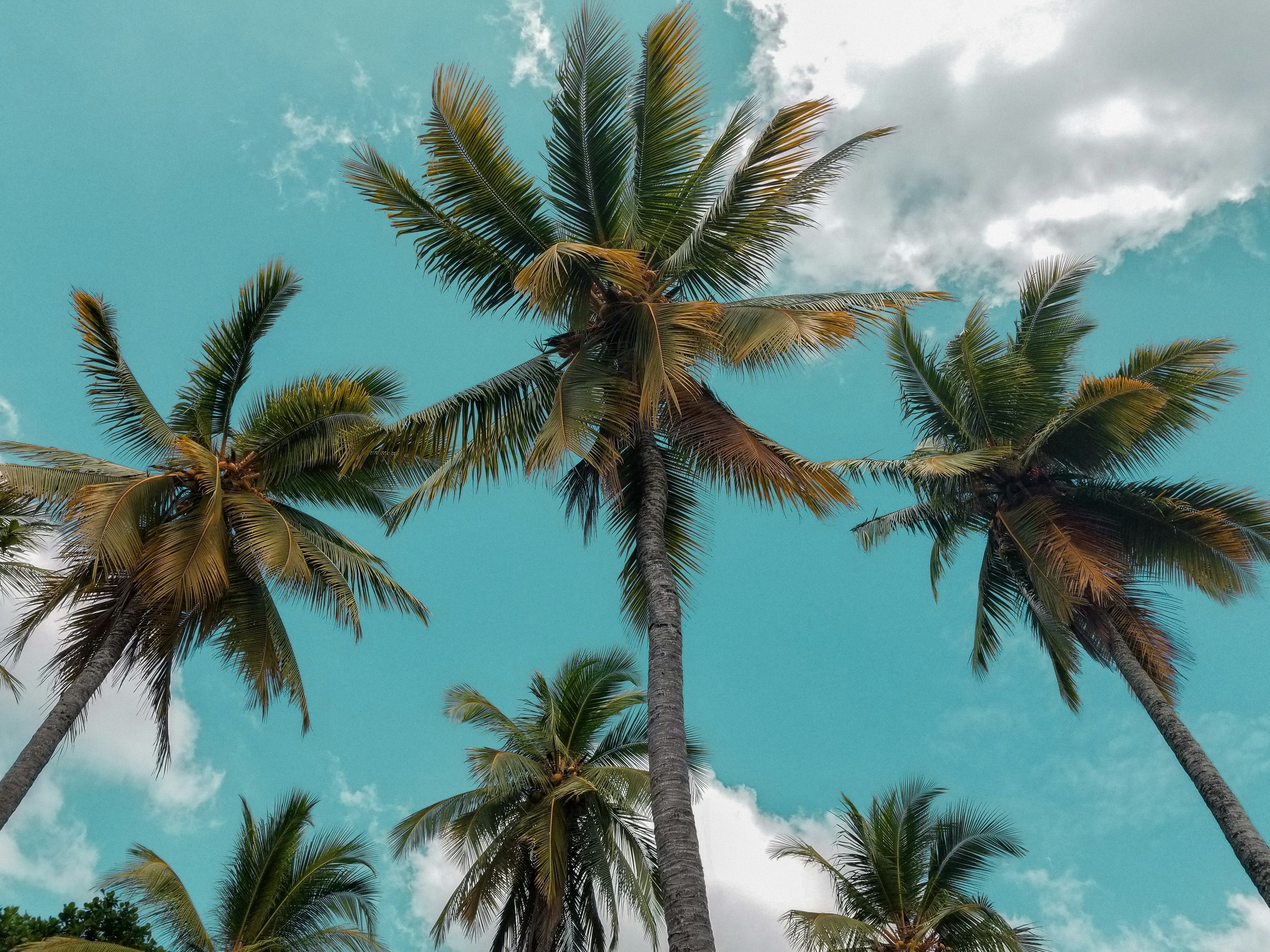
Explore Bentota - Sri Lanka Travel, Asia
Nestled along Sri Lanka’s southwestern coast, Bentota is a tropical paradise that blends golden beaches, vibrant culture, and thrilling adventures. Famous for its calm waters, luxury resorts, and scenic river estuary, Bentota has become a top destination for travelers seeking both relaxation and authentic experiences. From serene beach walks at sunrise to adrenaline-pumping water sports, this coastal town offers a perfect balance of leisure and exploration. With its proximity to Colombo and Galle, Bentota is easy to reach, making it an ideal stop for both short escapes and extended holidays.
Population: Approximately 37,000 in 2023.
Economy: Bentota’s economy thrives mainly on tourism, which drives local businesses such as hotels, restaurants, and wellness retreats. The town also benefits from fishing, coconut cultivation, and handicrafts like wood carving and batik textiles. Many residents rely on the growing demand for water sports and Ayurvedic treatments, making tourism the backbone of both income and employment in the area.
Landmarks: Famous for Bentota Beach, Bentota River Safari, and Kande Vihara Temple.
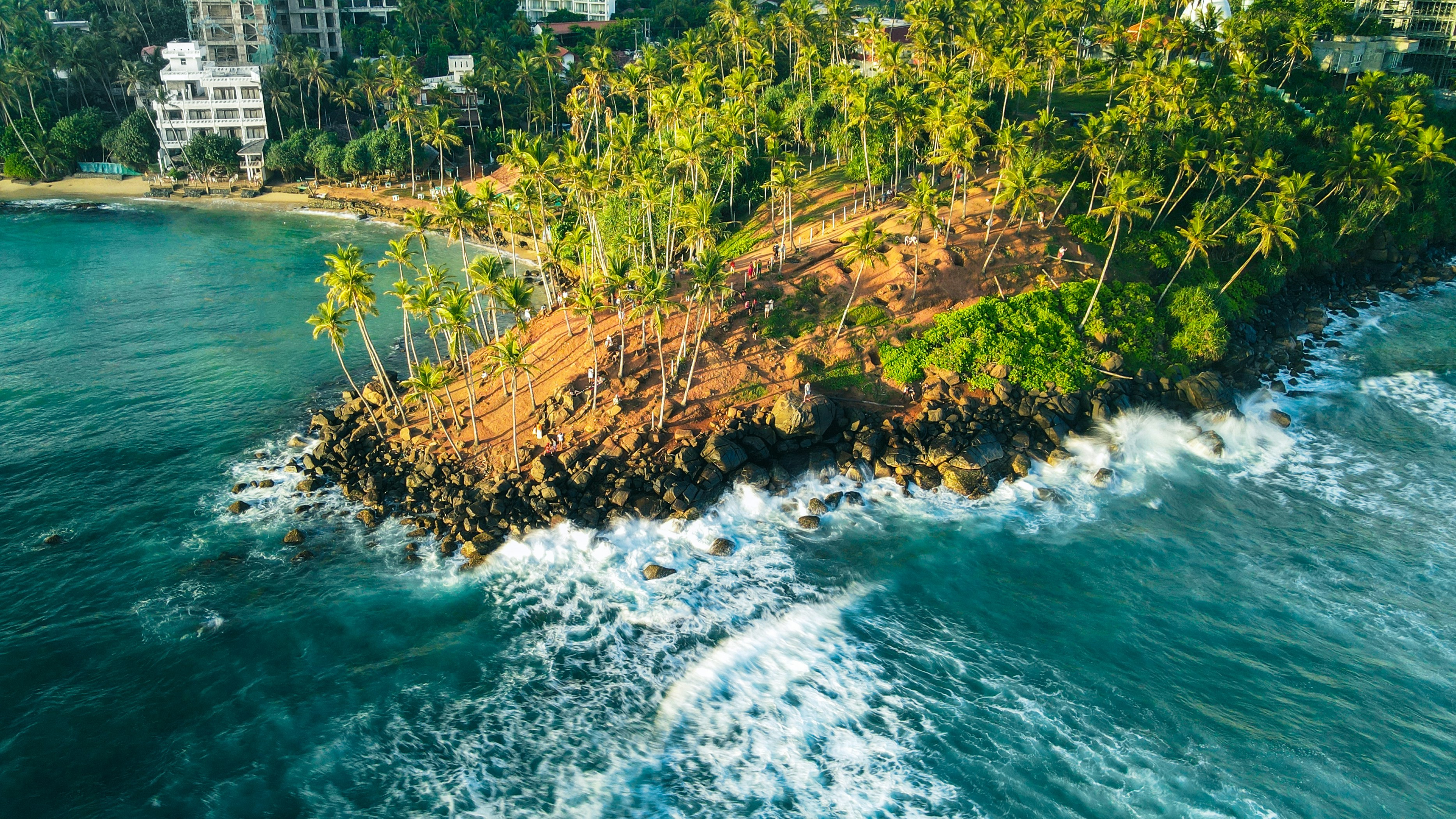
Explore Mirissa - Sri Lanka Travel, Asia
Mirissa is a charming coastal town on Sri Lanka’s southern shoreline. Known for its golden beaches, turquoise waters, and vibrant marine life, it has become a must-visit stop for travelers exploring the island. Many come for whale watching, surfing, and sunset views at Coconut Tree Hill, but Mirissa offers much more than postcard beauty. The fishing boats you see anchored by the bay carry generations of stories. Local traditions, delicious cuisine, and a laid-back rhythm of life shape every visitor’s experience.
Population: Approximately 4,700 in 2023.
Economy: Mirissa’s economy is largely shaped by its coastal location. Fishing has long been the backbone of local livelihoods, with generations relying on the Indian Ocean for income. In recent decades, tourism has become the main driver of growth, thanks to whale watching, surfing, and beachside hospitality.
Landmarks: Famous for Mirissa Beach, Coconut Tree Hill, and Parrot Rock Bridge.
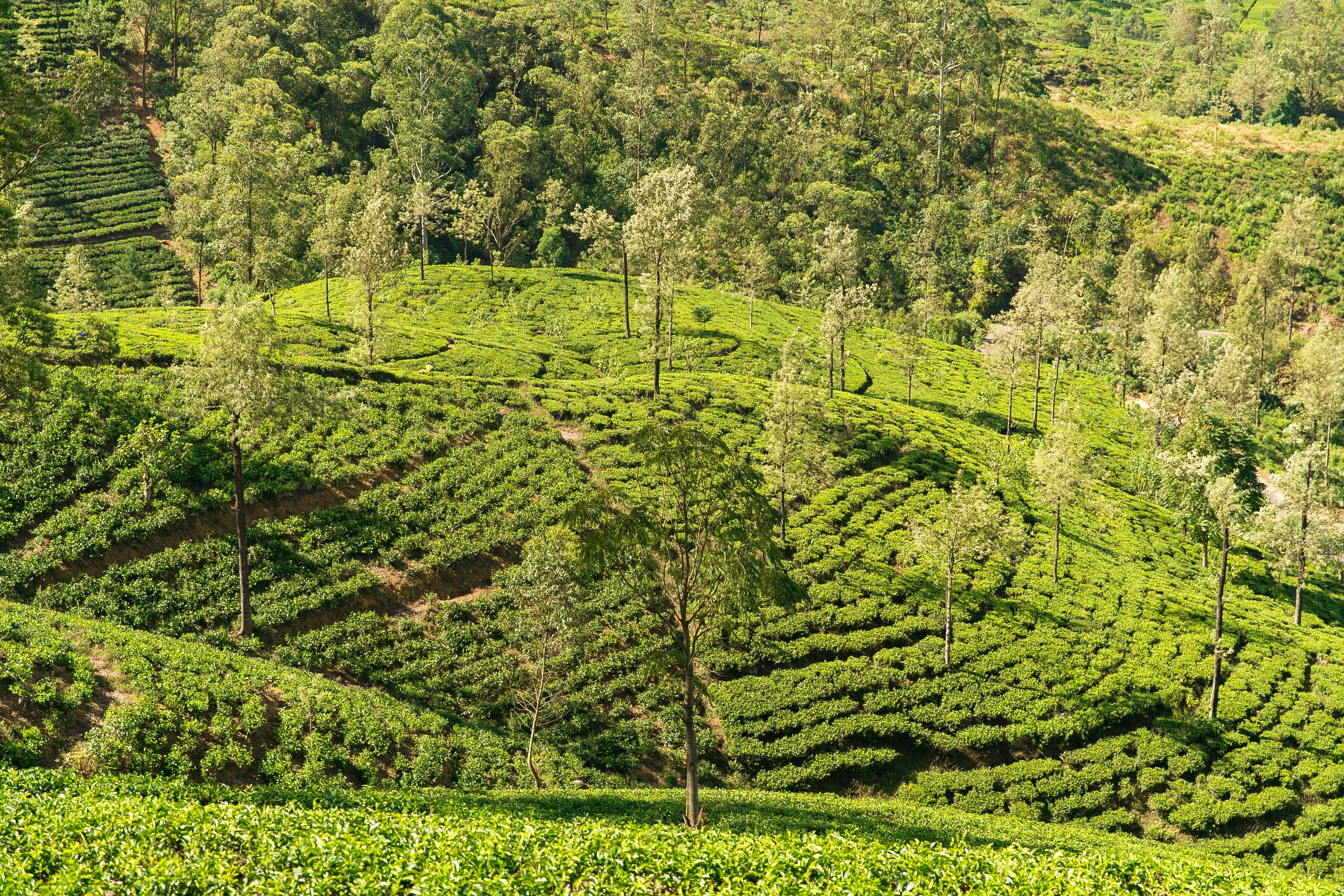
Explore Nuwara Eliya - Sri Lanka Travel, Asia
Tucked away in the Central Highlands of Sri Lanka, Nuwara Eliya is often called “Little England”. With its rolling tea plantations, cool misty mornings, and colonial charm, this mountain town feels like a step into another world. Travelers come here to breathe fresh air, walk through flower gardens, sip the finest Ceylon Tea, and enjoy a pace of life far from the island’s busy cities. Whether you’re drawn by scenic landscapes, heritage architecture, or the warmth of its people, Nuwara Eliya is a destination that blends nature, culture, and history in perfect harmony.
Population: Approximately 781,000 in 2023.
Economy: Nuwara Eliya’s economy thrives mainly on tea production, as it sits in the heart of Sri Lanka’s central highlands, famous worldwide for Ceylon Tea. The city also benefits from a growing tourism industry, attracting visitors with its colonial charm, cool climate, and scenic landscapes.
Landmarks: Famous for Gregory Lake, Hakgala Botanical Garden, and Victoria Park.
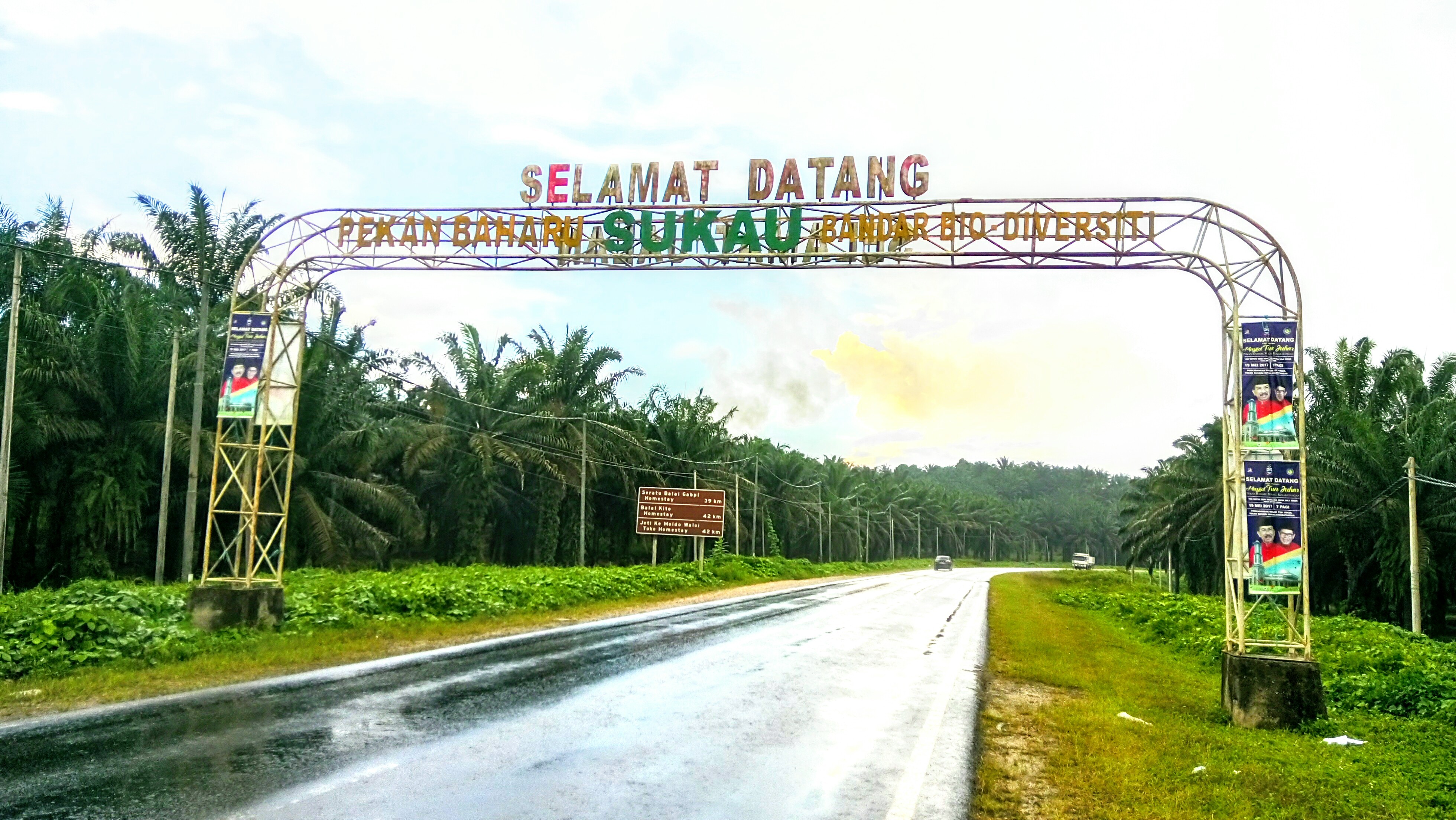
Explore Sukau - Malaysia Travel, Asia
Nestled on the banks of the Kinabatangan River in Sabah, Malaysian Borneo, Sukau is a destination where wildlife, culture, and conservation come together. Known as one of Asia’s top spots for river safaris and eco-tourism, this quiet village offers a front-row seat to encounters with Bornean orangutans, pygmy elephants, proboscis monkeys, and exotic birdlife.
Population: Approximately 1,400 in 2019.
Economy: Sukau’s economy is shaped by its riverine location and natural resources. Traditionally, the Orang Sungai community relied on fishing, small-scale farming, and forest gathering for their livelihood. Today, the village has shifted toward eco-tourism, with river cruises, jungle trekking, and homestays providing income.
Landmarks: Famous for the Kinabatangan River cruises, Gomantong Caves, and Ox-bow lakes and wetlands.
